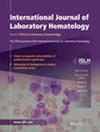Assessment of the Use of Available Resources for Diagnosing Diffuse Large B-Cell Lymphoma in an HIV-Prevalent Setting
Abstract
Background
Limited availability of diagnostic tests in low-resource settings hampers the diagnosis and classification of diffuse large B-cell lymphoma (DLBCL). A study was performed to assess the use of resources for classifying DLBCL in South Africa (SA) using ‘essential’ and ‘desirable’ investigations as per published guidelines.
Methods
A record review was performed of 74 patients newly diagnosed with DLBCL by tissue biopsy at the National Health Laboratory Service (NHLS) in Johannesburg between 1 January 2019 and 31 December 2022. The immunohistochemistry (IHC) and/or molecular work-up performed for the primary diagnosis of DLBCL and the associated costs were recorded.
Results
The primary diagnosis of DLBCL was based on 34 (45.9%) nodal and 40 (54.1%) extra-nodal biopsy sections. Overall, 60 (81.1%) were from participants living with human immunodeficiency virus (HIV) infection. ‘Essential’ IHC for CD3, CD10, CD20, Ki-67, BCL-2, BCL-6, MUM-1 and ‘desirable’ fluorescence in situ hybridisation (FISH) for MYC gene rearrangement were most requested for diagnosis. ‘Essential’ IHC for c-MYC was not performed because of non-availability of the testing. The ‘essential’ IHC was diagnostic in 97.3%. ‘Desirable’ FISH for MYC rearrangement was done in 56 (79.7%) cases, with additional FISH for BCL2 and BCL6 rearrangement performed in cases positive for MYC rearrangement. The average cost of diagnosis at the NHLS was half that of the recommended diagnostic testing.
Conclusion
The advocated ‘essential’ investigations, in addition to ‘desirable’ tests where necessary, enabled the accurate and cost-effective diagnosis of DLBCL in SA and are recommended for other parts of the world with limited resources.

 求助内容:
求助内容: 应助结果提醒方式:
应助结果提醒方式:


